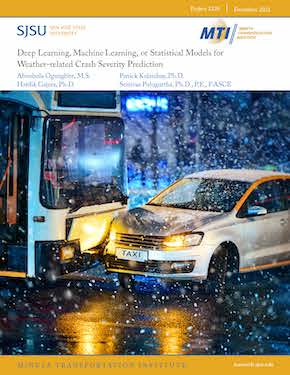- 408-924-7560
- mineta-institute@sjsu.edu
- Donate
Deep Learning, Machine Learning, or Statistical Models for Weather-related Crash Severity Prediction
Nearly 5,000 people are killed and more than 418,000 are injured in weather-related traffic incidents each year. Assessments of the effectiveness of statistical models applied to crash severity prediction compared to machine learning (ML) and deep learning techniques (DL) help researchers and practitioners know what models are most effective under specific conditions. Given the class imbalance in crash data, the synthetic minority over-sampling technique for nominal (SMOTE-N) data was employed to generate synthetic samples for the minority class. The ordered logit model (OLM) and the ordered probit model (OPM) were evaluated as statistical models, while random forest (RF) and XGBoost were evaluated as ML models. For DL, multi-layer perceptron (MLP) and TabNet were evaluated. The performance of these models varied across severity levels, with property damage only (PDO) predictions performing the best and severe injury predictions performing the worst. The TabNet model performed best in predicting severe injury and PDO crashes, while RF was the most effective in predicting moderate injury crashes. However, all models struggled with severe injury classification, indicating the potential need for model refinement and exploration of other techniques. Hence, the choice of model depends on the specific application and the relative costs of false negatives and false positives. This conclusion underscores the need for further research in this area to improve the prediction accuracy of severe and moderate injury incidents, ultimately improving available data that can be used to increase road safety.
ABIMBOLA OGUNGBIRE, MS
Mr. Ogungbire is pursuing his Ph.D. in the Infrastructure and Environmental Systems (INES) program at the University of North Carolina at Charlotte. His areas of interest are traffic data analytics and visualization.
PANICK KALAMBAY, PHD
Dr. Kalambay recently graduated with his doctoral degree in Civil Engineering at the University of North Carolina at Charlotte. His areas of interest are traffic operations & safety, and transportation planning.
HARDIK GAJERA, PHD
Dr. Gajera recently graduated with his doctoral degree in Civil Engineering at the University of North Carolina at Charlotte. His areas of interest include traffic operations & safety, traffic simulations, and connected & automated vehicles.
SRINIVAS S. PULUGURTHA, PHD, PE, FASCE
Dr. Pulugurtha is currently working as a Professor and Research Director of the Department of Civil and Environmental Engineering at the University of North Carolina at Charlotte.
-
Contact Us
San José State University One Washington Square, San Jose, CA 95192 Phone: 408-924-7560 Email: mineta-institute@sjsu.edu






